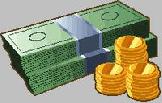
 |
|
| Financial Terms | |
| dividend discount model |
|
Information about financial, finance, business, accounting, payroll, inventory, investment, money, inventory control, stock trading, financial advisor, tax advisor, credit.
Main Page: financial advisor, accounting, money, payroll, business, finance, tax advisor, stock trading, |
Definition of dividend discount model
dividend discount modelComputation of today’s stock price which states that share value equals the present value of all expected future dividends.
Related Terms:Dividend discount model (DDM)A model for valuing the common stock of a company, based on the constant-growth dividend discount modelVersion of the dividend discount model in which dividends grow at a constant rate. Discounted dividend model (DDM)A formula to estimate the intrinsic value of a firm by figuring the Attribute biasThe tendency of stocks preferred by the dividend discount model to share certain equity Three-phase DDMA version of the dividend discount model which applies a different expected dividend ADF (annuity discount factor)the present value of a finite stream of cash flows for every beginning $1 of cash flow. DLOC (discount for lack of control)an amount or percentage deducted from a pro rata share of the value of 100% of an equity interest in a business, to reflect the absence of some or all of the powers of control.  DLOM (discount for lack of marketability)an amount or percentage deducted from an equity interest to reflect lack of marketability. economic components modelAbrams’ model for calculating DLOM based on the interaction of discounts from four economic components. discount ratethe rate of return on investment that would be required by a prudent investor to invest in an asset with a specific level risk. Also, a rate of return used to convert a monetary sum, payable or receivable in the future, into present value. fractional interest discountthe combined discounts for lack of control and marketability. g the constant growth rate in cash flows or net income used in the ADF, Gordon model, or present value factor. Gordon modelpresent value of a perpetuity with growth. log size modelAbrams’ model to calculate discount rates as a function of the logarithm of the value of the firm. QMDM (quantitative marketability discount model)model for calculating DLOM for minority interests r the discount rate Accretion (of a discount)In portfolio accounting, a straight-line accumulation of capital gains on discount Arbitrage-free option-pricing modelsYield curve option-pricing models.  Asset pricing modelA model for determining the required rate of return on an asset. Asset pricing modelA model, such as the Capital Asset Pricing model (CAPM), that determines the required Bank discount basisA convention used for quoting bids and offers for treasury bills in terms of annualized Binomial option pricing modelAn option pricing model in which the underlying asset can take on only two Black-Scholes option-pricing modelA model for pricing call options based on arbitrage arguments that uses Capital asset pricing model (CAPM)An economic theory that describes the relationship between risk and Cash discountAn incentive offered to purchasers of a firm's product for payment within a specified time Cash dividendA dividend paid in cash to a company's shareholders. The amount is normally based on Constant-growth modelAlso called the Gordon-Shapiro model, an application of the dividend discount Cum dividendWith dividend. Cumulative dividend featureA requirement that any missed preferred or preference stock dividends be paid Deep-discount bondA bond issued with a very low coupon or no coupon and selling at a price far below par Deterministic modelsLiability-matching models that assume that the liability payments and the asset cash DiscountReferring to the selling price of a bond, a price below its par value. Related: premium. Discount bondDebt sold for less than its principal value. If a discount bond pays no interest, it is called a Discount factorPresent value of $1 received at a stated future date. Discount periodThe period during which a customer can deduct the discount from the net amount of the bill Discount rateThe interest rate that the Federal Reserve charges a bank to borrow funds when a bank is Discount securitiesNon-interest-bearing money market instruments that are issued at a discount and Discount windowFacility provided by the Fed enabling member banks to borrow reserves against collateral Discounted basisSelling something on a discounted basis is selling below what its value will be at maturity, Discounted cash flow (DCF)Future cash flows multiplied by discount factors to obtain present values. Discounted payback period ruleAn investment decision rule in which the cash flows are discounted at an DiscountingCalculating the present value of a future amount. The process is opposite to compounding. DividendA dividend is a portion of a company's profit paid to common and preferred shareholders. A stock Dividend clawbackWith respect to a project financing, an arrangement under which the sponsors of a project Dividend clienteleA group of shareholders who prefer that the firm follow a particular dividend policy. For Dividend growth modelA model wherein dividends are assumed to be at a constant rate in perpetuity. Dividend limitationA bond covenant that restricts in some way the firm's ability to pay cash dividends. Dividend payout ratioPercentage of earnings paid out as dividends. Dividends per shareAmount of cash paid to shareholders expressed as dollars per share. Dividend policyAn established guide for the firm to determine the amount of money it will pay as dividends. Dividend rateThe fixed or floating rate paid on preferred stock based on par value. Dividend reinvestment plan (DRP)Automatic reinvestment of shareholder dividends in more shares of a Dividend rightsA shareholders' rights to receive per-share dividends identical to those other shareholders receive. Dividend yield (Funds)Indicated yield represents return on a share of a mutual fund held over the past 12 Dividend yield (Stocks)Indicated yield represents annual dividends divided by current stock price. Dividends per sharedividends paid for the past 12 months divided by the number of common shares Documented discount notesCommercial paper backed by normal bank lines plus a letter of credit from a Extra or special dividendsA dividend that is paid in addition to a firm's "regular" quarterly dividend. Extrapolative statistical modelsmodels that apply a formula to historical data and project results for a Ex-dividendThis literally means "without dividend." The buyer of shares when they are quoted ex-dividend Ex-dividend dateThe first day of trading when the seller, rather than the buyer, of a stock will be entitled to Factor modelA way of decomposing the factors that influence a security's rate of return into common and Forward discountA currency trades at a forward discount when its forward price is lower than its spot price. Garmen-Kohlhagen option pricing modelA widely used model for pricing foreign currency options. Homemade dividendSale of some shares of stock to get cash that would be similar to receiving a cash dividend. Index modelA model of stock returns using a market index such as the S&P 500 to represent common or Indicated dividendTotal amount of dividends that would be paid on a share of stock over the next 12 months Liquidating dividendPayment by a firm to its owners from capital rather than from earnings. Market modelThis relationship is sometimes called the single-index model. The market model says that the ModelingThe process of creating a depiction of reality, such as a graph, picture, or mathematical Original issue discount debt (OID debt)Debt that is initially offered at a price below par. Perfect market view (of dividend policy)Analysis of a decision on dividend policy, in a perfect capital Pie model of capital structureA model of the debt/equity ratio of the firms, graphically depicted in slices of Pure-discount bondA bond that will make only one payment of principal and interest. Also called a zerocoupon Residual dividend approachAn approach that suggests that a firm pay dividends if and only if acceptable Single factor modelA model of security returns that acknowledges only one common factor. Single index modelA model of stock returns that decomposes influences on returns into a systematic factor, Signaling view (on dividend policy)The argument that dividend changes are important signals to investors Simple linear trend modelAn extrapolative statistical model that asserts that earnings have a base level and Single-index modelRelated: market model Special dividendAlso referred to as an extra dividend. dividend that is unlikely to be repeated. Stochastic modelsLiability-matching models that assume that the liability payments and the asset cash flows Stock dividendPayment of a corporate dividend in the form of stock rather than cash. The stock dividend Tax differential view ( of dividend policy)The view that shareholders prefer capital gains over dividends, Traditional view (of dividend policy)An argument that "within reason," investors prefer large dividends to Two-factor modelBlack's zero-beta version of the capital asset pricing model. Two-state option pricing modelAn option pricing model in which the underlying asset can take on only two Value-at-Risk model (VAR)Procedure for estimating the probability of portfolio losses exceeding some With dividendPurchase of shares in which the buyer is entitled to the forthcoming dividend. Related: exdividend. Yield curve option-pricing modelsmodels that can incorporate different volatility assumptions along the DividendA payment a company makes to stockholders. Earnings before income tax. The profit a company made Discounted cash flow (DCF)A method of investment appraisal that discounts future cash flows to present value using a discount rate, which is the risk-adjusted cost of capital. DividendThe payment of after-tax profits to shareholders as their share of the profits of the business for an accounting period. Dividend incomeIncome that a company receives in the form of dividends on stock in other companies that it holds. DividendsAmounts paid to the owners of a company that represent a share of the income of the company. Purchase discountsA contra account that reduces purchases by the amount of the discounts taken for early payment. Sales discountsA contra account that offsets revenue. It represents the amount of the discounts for early payment allowed on sales. discounted cash flow (DCF)Refers to a capital investment analysis technique dividend payout ratioComputed by dividing cash dividends for the year dividend yield ratioCash dividends paid by a business over the most Capital Asset Pricing Model (CAPM)A model for estimating equilibrium rates of return and values of Related to : financial, finance, business, accounting, payroll, inventory, investment, money, inventory control, stock trading, financial advisor, tax advisor, credit. |